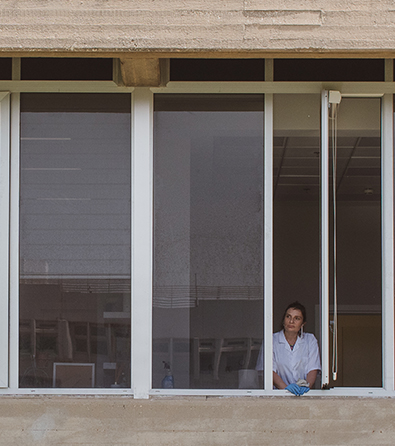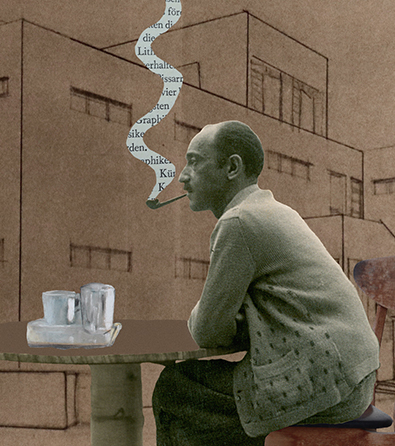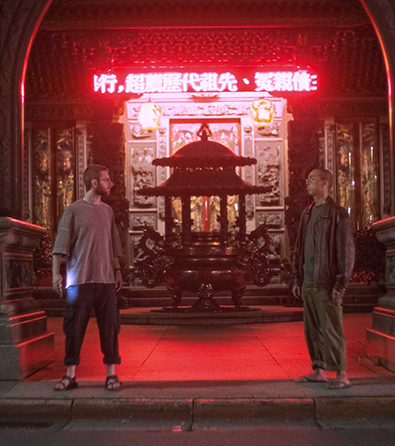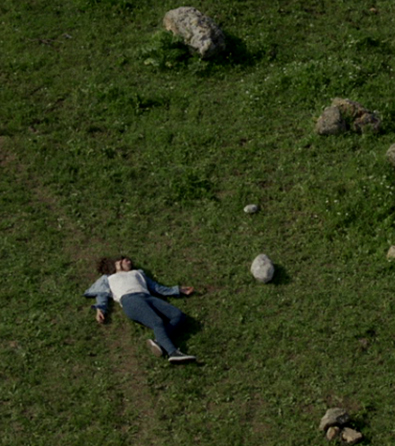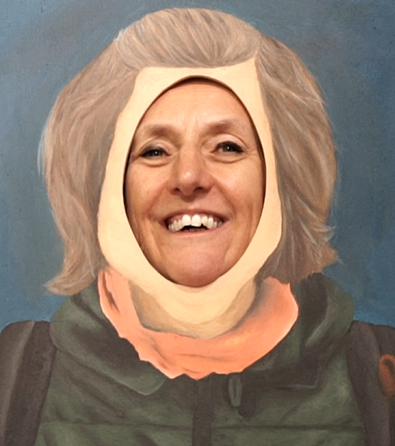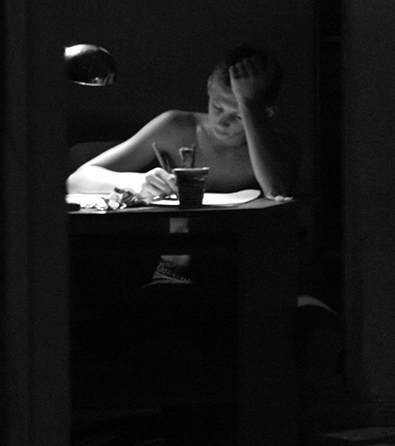The short film Abir (25 minutes) is available at the top of the page.
* To watch this film, please approve YouTube/Vimeo cookies via the blue cookie icon at the bottom left of the screen
The short narrative film Abir, directed by Noga Mer, raises questions about the tensions between the center and the margins in Israeli society. Focusing on the complex bond between Keren (Dorit Lev Ari) and her cousin Abir (Osher Maimon), the film resonates with an ongoing cinematic discourse around otherness in Israeli culture. Abir, who has spent thirty years disconnected from society and living on the streets, emerges as a subversive, marginal character who challenges common narratives surrounding family, relationships, bereavement, and mourning. Throughout the film, Abir consistently undermines the social structures that prescribe normative responses to trauma. He is portrayed as a nonconformist who rejects social norms and the conventional framework of Israeli bereavement, with the film’s expressive language emphasizing his social and cultural estrangement.
The portrayal of the “other” in Israeli cinema has undergone significant changes over time. Early films often depicted collective groups—Palestinians, Mizrahim, Holocaust survivors, and immigrants—while later works shifted toward socially marginalized individuals, such as drug addicts and people living with mental illness, often portraying them as passive and hopeless protagonists. In her book “Holocaust Survivors, Aliens and Others in Israeli Cinema and Literature”, cultural and film scholar Nurith Gertz examines how Israeli cinema gives voice to characters pushed to the margins, framing the “other” not merely as a narrative figure but also as an ideological stance that challenges and redefines the viewer’s boundaries of identification. In this context, Abir follows the tradition of representing the “other,” yet simultaneously breaks away from it: he is not portrayed as a weak or defeated character belonging to a collective, but rather as a charismatic, individualistic character who refuses to submit to social norms.
Keren welcomes Abir into her home and serves as a bridge between the structured world and Abir’s perception of reality. She is torn between her desire to devote herself to a normative life and her fascination with the margins. Part of her wish to help Abir stems from a sense of responsibility toward the poor and the ill. Through her encounter with Abir, Keren undergoes a transformative process, reexamining the meaning of a normative life.
Through their relationship, the film explores the boundaries between social norms and transgression, between the correct way of living and living outside the accepted social framework. The nature of the bond between Keren and Abir shatters the traditional dynamic of rescuer and rescued: on the surface, Keren appears to be the one saving Abir by welcoming him into her home, an act that also grants her a sense of superiority over him. Yet as the film progresses, it becomes clear that Abir is the one who gives Keren a sense of vitality and liberates her from her hollow routine. A reversal unfolds, in which the seemingly clumsy, incapable, and weak figure becomes a transformative force for the normative character. Not only does Abir refuse to be treated by her, but he also confronts her with the void in her life and raises doubts about the proper ways to behave in public spaces, including during funeral ceremonies and memorial services at the cemetery. He employs sharp, subversive, and mocking language to challenge the Israeli myth of the victim-hero and the glorification of death and trauma.
In her article “Chronic Trauma, the Sound of Terror, and Current Israeli Cinema,” film scholar Raya Morag presents the term “Chronic Trauma” as a condition in which Israeli society remains trapped within an ongoing traumatic memory, preventing true processing of pain and instead enshrining it within the Israeli public sphere and collective experience. The protagonists of Israeli cinema echo this chronic national trauma even when the film’s focus appears to be a personal story. In contrast to this condition, Abir offers an alternative: Abir leaves the streets – the informal Israeli public space – and accompanies Keren as she moves through the institutionalized public spaces of the bourgeoisie, such as the supermarket, the movie theater, and the cemetery. In the supermarket, he refuses to participate in consumer culture; in the movie theater, he responds as an enthusiastic and vocal viewer, resisting the expectation to remain silent and suppress emotion; and at the cemetery, he mocks the culture and norms of mourning, exposing their artificiality.
Abir leads Keren through these physical spaces, and the scenes gradually accumulate into a sharp social critique of the society in which Keren lives. The film’s unique structure, shifting between the private space and the public, the intimate and the outspoken, gradually builds Abir’s response to the Israeli society among which Keren lives. From this emerges the understanding that Abir is not merely a story about the relationship between Keren and Abir, but also serves as a manifesto against the exclusion of others in Israeli society and as a mirror image of that society. It is precisely through their private daily life scenes and their conversations, which do not directly address the national trauma, that the film becomes charged with collective meaning, compelling the viewer to reconsider how the “other” is perceived within the national narrative and what social reflection he offers. The direction deliberately moves between Keren’s point of view of Abir and Abir’s point of view of the society and norms from which he has excluded himself.
The film resonates with a cinematic tradition that critiques social norms and structures, collective memory, and the exclusion of voices that do not conform to the Bon Ton. The direction, which centers on Keren’s experience and her perspective on Abir, together with the cinematography, which observes Abir’s body and behavior, creates a cinematic experience greater than the sum of its parts. Dorit Lev Ari and Osher Maimon deliver iconic performances that echo roles they have portrayed in series and films in which they represented, respectively, the Israeli bourgeoisie and the homeless. The uniqueness of Abir lies in the reflexive gaze enabled by its long takes, and in the ability of Lev Ari and Maimon to view their characters also from the outside.
The tension between the camera’s external gaze and the actors’ self-awareness of their social class representations also reflects the tension between the expectation for Abir to be either a knight on a white horse or a noble savage, and the actual role he fulfills within the story. The camera frames Abir’s body and movements within wide shots that situate him in the space. The use of space and the cinematic language, beginning with wide frames that confine the characters within their environment and concluding with tighter frames, visually and wordlessly complement the evolving relationship between Abir and Keren. The film’s strength lies in its perspective on Abir: he is not portrayed as a tragic protagonist, but as an entity moving through closed spaces that fail to contain the vitality, sincerity, and force of his personality.
In Israel, there are approximately fifteen university departments, colleges, and film schools where dozens of short films are produced each year. Most often, their narratives revolve around the story of the Israeli middle class. The School of Audio & Visual Arts at Sapir College, located in the south of Israel, stands out for producing short films that frequently address the social, economic, and political tensions of the Israeli periphery. The periphery in all its forms – whether social, cultural, or mental – is represented in the films produced by the school, and over the years, this has evolved into a profound inquiry of both content and form. This development is thanks in part to the International Cinema South Festival, which each year curates works from the global periphery or films that engage with international social or economic margins.
The significant body of work produced by Sapir College’s films forms a layered and rich portrait of the Israeli periphery and stands as a testament to its longstanding neglect. Especially after the massacre of October 7, 2023, these films tell the stories of many communities from the south of Israel that were attacked that day, and it is essential to listen to them and to watch them.
